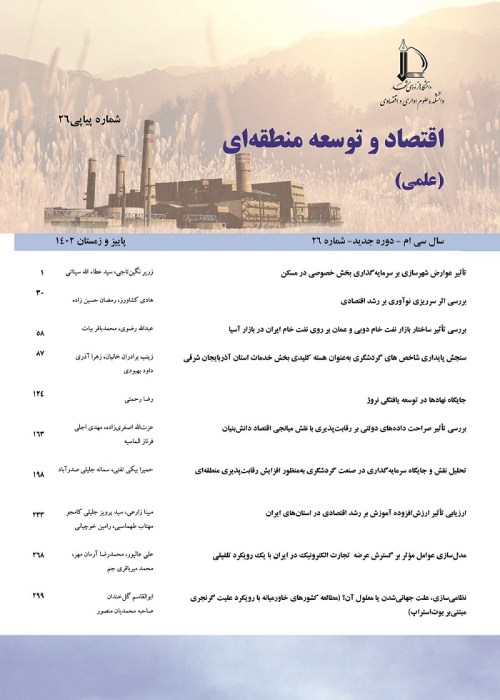Investigating and Comparing the Asymmetric Effect of Oil Price Shocks on the Food Price in Oil Exporting and Oil Importing Countries
Author(s):
Article Type:
Research/Original Article (دارای رتبه معتبر)
Abstract:
Introduction
The high volatility of food prices is a concern to the general public and policy makers because such price movements are a deterrent to increased agricultural productivity and they tend to intensify inflationary pressures (Karagbo, 2005, p. 205). In recent years, the rising trend in global oil and food prices has been a source of interest to researchers to explore the relationship between these two variables; thus, many studies have been focused on the relationship between these two variables (Alghalith, 2010; Baffes, 2007; Headey & Fan, 2008). In this regard, the main purpose of this paper is to investigate the impact of the oil price shocks on the food price in the oil exporting (including Iran, Russia, Saudi Arabic, Norway, Venezuela, Kuwait, and Nigeria) as well as the oil importing countries (including UAS, Japan, Chin, South Korea, France, India, and Spain).Theoretical frame work: The rapid increase of commodity price causes tension in most countries, regardless of whether they are among the developed or developing countries. Oil and food prices have a strong impact on macroeconomic variables.
After the oil boom in 1970s, studies on the oil price shock attracted the attention of many researchers because it was one of the most effective causes of a universal economic slowdown, especially in oil importing countries (Alom et al., 2011). Despite numerous researches showing the impact of the oil price shock on local or/and global economy, less studies have illustrated the role of the oil price shock in food prices. Results and outcome were mixed with different explanations. These explanations can be approximately divided into two categories: Demand side and supply side factors. The demand side factors considered the fundamental force of rising food prices. As a result, increasing population, rapid economic growth, rising consumption, and rapid increase in the production of biofuel and ethanol, etc. led to the increase in the aggregate demand on agriculture commodities which finally caused food prices to increase. Supply-side factors were also cited highlighting higher agricultural prices. Among others, slow growth in agricultural production, soaring crude oil prices, and droughts were more pronounced supply-side explanations (Abdlaziz et al., 2016).
Feedstock demand for biofuel and its relation to the oil price seemed to keep their roles in determining the recent behavior of agricultural product prices and were considered as some of the important factors of agricultural commodity demand and agricultural prices. Other studies indicated the relationship between food and oil prices as the factors of rising production of biofuels (Gilbert, 2010). Baffes (2007), Yu et al. (2006), and Zhang and Reed (2008) tried to investigate the dynamics of oil and agricultural commodity interconnection. Yu et al. (2006) could not discover any effect of oil prices on the edible oil prices (sunfower oil, olive oil, and palm oil) and the agricultural raw material prices index, respectively. Zhang and Reed (2008) also found that oil price fluctuations did not affect different types of agricultural commodities prices in China like corn, soy meal, and pork. Similar results were found by Nazlioglu and Soytas (2010) inTurkey. Moreover, Nazlioglu (2011) concluded that there is no linear causality between the oil price and agricultural commodities but found a non-linear relation between the oil and food prices.
Baffes and Dennis (2013) found evidence of a strong impact of the oil price change on the food price index. However, he suggested that individual commodity prices should be analyzed separately. In a more recent study, Ibrahim (2015) pointed that there exists a long-run relation between the oil price increase and the food price, while the long-term oil price reduction and the food price is non-existent. Baffes and Haniotis (2010) found that the highest pass-through from energy prices to non-energy prices exists for fertilizer which is specifically followed by agriculture in general.While detecting the impact of petroleum prices on food prices, exchange rate movements have a great role and its importance cannot be ignored. Nazlioglu and Soytas (2012) explained the relationship between the oil price and the 24 world agricultural commodity prices in panel setting. They found strong evidence of transmission from world oil price to agricultural commodity prices, on one side and a positive impact of the weak dollar on food prices on the another side.
Methodology
In this paper, in order to estimate the asymmetric effects of oil shocks on the food price index in the selected oil exporting and oil importing countries, we used the Karagbo (2005) paper model, which includes foreign exchange and monetary and trading policies by adjusting, including, and adding variables of positive and negative oil prices shocks, logarithmically and in the form of panel data as follows: (1)In Eq. (1), countries are denoted by the subscript i and the subscript t denotes the time period (1995-2014). Other variables are defined as follows: Ln: natural logarithm; fpi: food price index (2005=100); y: income per capita; exr: real exchange rate; m2: The volume of liquidity; open: The degree of the economic openness index by the ratio of the sum of exports and imports to the gross domestic product; dfp: Food Production Index (2005=100); oilp: positive shocks of oil price; oilp-: negative shocks of oil price.
In order to estimate the model, first, positive and negative oil price shocks have been extracted by using Granger and Yoon (2002) method. Then the panel co-integration tests confirmed the asymmetric long-run equilibrium relationship. In the end, the non-linear Panel Mean Group (PMG) approach was used to measure the asymmetric effects.
Results and Discussion
The findings show that, positive (negative) shocks of oil price, increased (decreased) the food price index in both the oil exporting and oil importing countries and the impact of the positive shocks is more than the negative shocks (confirm the effects of asymmetric). Also, the effect of positive shocks (negative) in oil-exporting countries is more (less) than oil-importing countries. According to the other results, monetary policy in oil-exporting countries and exchange policy in oil-importing countries have the most influence on the food price index.Conclusions & Suggestions: Based on the results, it can be said that the vulnerability of oil exporting countries is higher than the oil importing countries in confronting with oil shocks from the direction food price index. Also, monetary policy in oil-exporting countries and exchange policy in oil-importing countries have the most influence on the food price index. Accordingly, controlling the volume of liquidity in oil-exporting countries and controlling the exchange rates in oil-importing countries could have an important impact on the food price reductions in these countries.
Keywords:
Language:
Persian
Published:
Journal of Economy and Regional Development, Volume:24 Issue: 14, 2018
Pages:
121 to 147
magiran.com/p1837538
دانلود و مطالعه متن این مقاله با یکی از روشهای زیر امکان پذیر است:
اشتراک شخصی
با عضویت و پرداخت آنلاین حق اشتراک یکساله به مبلغ 1,390,000ريال میتوانید 70 عنوان مطلب دانلود کنید!
اشتراک سازمانی
به کتابخانه دانشگاه یا محل کار خود پیشنهاد کنید تا اشتراک سازمانی این پایگاه را برای دسترسی نامحدود همه کاربران به متن مطالب تهیه نمایند!
توجه!
- حق عضویت دریافتی صرف حمایت از نشریات عضو و نگهداری، تکمیل و توسعه مگیران میشود.
- پرداخت حق اشتراک و دانلود مقالات اجازه بازنشر آن در سایر رسانههای چاپی و دیجیتال را به کاربر نمیدهد.
In order to view content subscription is required
Personal subscription
Subscribe magiran.com for 70 € euros via PayPal and download 70 articles during a year.
Organization subscription
Please contact us to subscribe your university or library for unlimited access!



